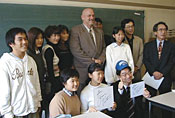Why the Difference?
By Martin Kaste
November 8, 1999
Governor Ventura visited a model Tokyo High School early this morning, and, as usual, he was a big hit with the kids. His philosophy of smaller class sizes was also popular among the students, who say Japan might have something to learn from the U.S. when it comes to giving children individualized attention.
THE NAME "JESSE VENTURA"
was not
familiar to the students at Tsukuba High
School; to Ventura's dismay, they apparently haven't even seen his movies.
On the other hand, Japanese educators are also trying to shrink their classes. Tsukuba High has recently reduced them from 45 students per room to 40, and the vice-principal, Mr. Hiroi, says the school would like to reduce them even more. Through an interpreter, Hiroi says the change has made a real difference.
As long as their English teacher continued giving the day's lesson, all 40 of them kept their noses in their books, somehow managing to ignore the arrival of four TV cameras, three photographers, foreign reporters and one very large bald man who had come to watch them study.
By Martin Kaste
November 8, 1999
Governor Ventura visited a model Tokyo High School early this morning, and, as usual, he was a big hit with the kids. His philosophy of smaller class sizes was also popular among the students, who say Japan might have something to learn from the U.S. when it comes to giving children individualized attention.
| |
|
|
|
||
Ventura: Did you see the movie "Predator"?But as he does everywhere, Ventura quickly found a way to connect with these kids, especially when one of them shyly asked him about the bodyguards who follow him around.
Students: Pradatu?
Ventura: No?! Really? None of you have seen "Predator"?
Ventura: I used to be a bodyguard.Ventura and his staff spent about an hour at Tsukuba High, which is a very selective public institution run by a university. Despite the school's elite status, many of the Minnesotans on the visit remarked privately how shabby the facilities seemed compared to a Minnesota school, and how crowded the classrooms were. Class size is one of Ventura's favorite themes; he's pushed for state money to reduce the student-teacher ratios in the early grades. But it was a Japanese student who brought the matter up.
Kids: Oooh!
Ventura: In fact, I was, for the Rolling Stones.
Matsumoto: We have 40 people in a class, and all the desks are lined up, and what do you think of those differences?That philosophy is not necessarily shared by all education experts, or even all state legislators. Some have tried to argue that there's no proof of a direct connection between the student-teacher ratio and the quality of the education. Japanese students, for example, consistently out-perform their American counterparts on standardized tests, despite being crammed into larger classes.
Ventura: Well, I think that certainly, economics always enters in, you know, money. Money enters into education. But we feel -- I feel very strongly -- especially in our state of Minnesota, that the smaller the class size, the better the learning is for the student.
On the other hand, Japanese educators are also trying to shrink their classes. Tsukuba High has recently reduced them from 45 students per room to 40, and the vice-principal, Mr. Hiroi, says the school would like to reduce them even more. Through an interpreter, Hiroi says the change has made a real difference.
Hiroi: Right now, the school can respect more individuality, so the smaller must be better.The desire for individual attention is echoed by Tchihira Matsumoto, the student who asked Ventura the question about class size. Matsumoto has attended school in America as well as in Japan.
Matsumoto: I think Japanese schools should adopt things from American schools, like, the way they teach. In Japanese schools, they just try to stuff all the work into your head, but in the U.S., they, the teachers, think about each student.The governor also says he doesn't see any reason to question his belief in smaller class sizes, even after seeing how successful the Japanese schools have been with 40 students or more per class. He says the difference is cultural.
Ventura: They're a much more formal people than we are. So I think that larger class sizes will work better here than they would in America, I believe. And besides, we haven't had lower class sizes long enough to make that comparison.The cultural differences in the classrooms are hard to ignore. During Ventura's visit, the Japanese students were amazingly disciplined.
As long as their English teacher continued giving the day's lesson, all 40 of them kept their noses in their books, somehow managing to ignore the arrival of four TV cameras, three photographers, foreign reporters and one very large bald man who had come to watch them study.

